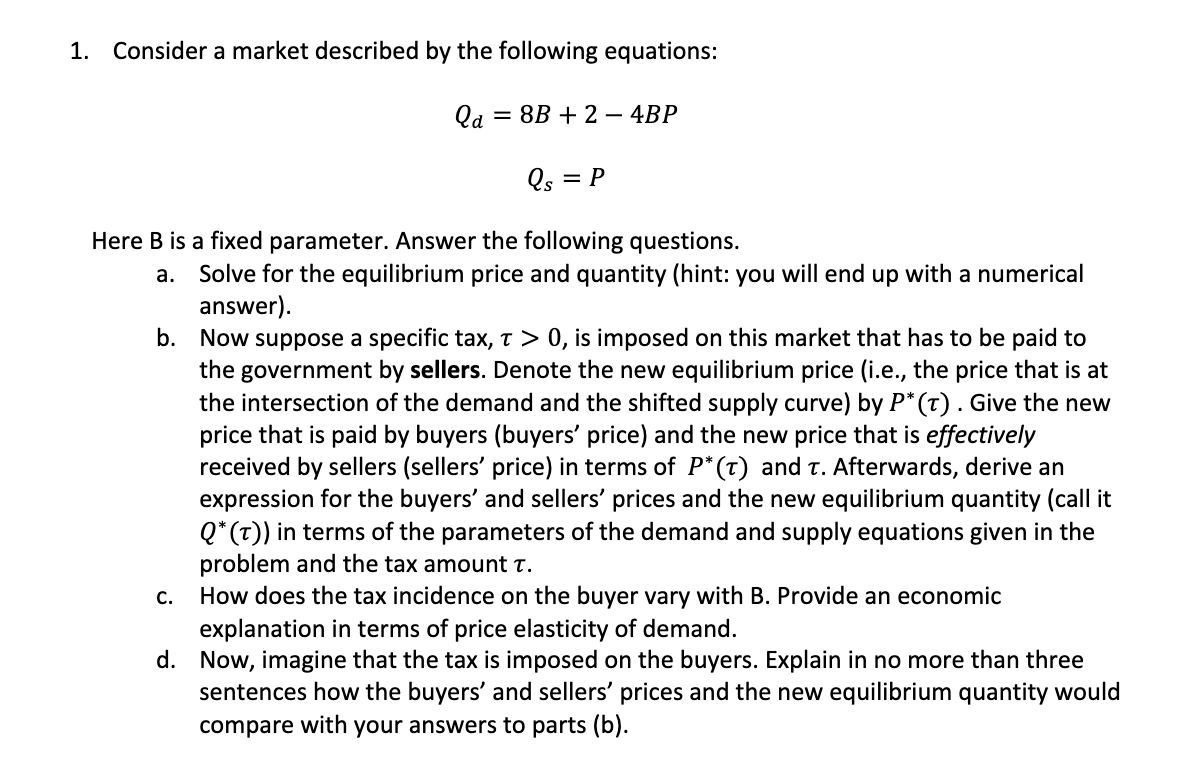answer). Now suppose a specific tax, t > 0, is imposed on this market that has to be paid to the government by sellers. Denote the new equilibrium price (i.e., the price that is at the intersection of the demand and the shifted supply curve) by P*(t) . Give the new price that is paid by buyers (buyers' price) and the new price that is effectively received by sellers (sellers' price) in terms of P*(t) and t. Afterwards, derive an expression for the buyers' and sellers' prices and the new equilibrium quantity (call it Q*(t)) in terms of the parameters of the demand and supply equations given in the problem and the tax amount t. How does the tax incidence on the buyer vary with B. Provide an economic explanation in terms of price elasticity of demand. Now, imagine that the tax is imposed on the buyers. Explain in no more than three sentences how the buyers' and sellers' prices and the new equilibrium quantity would compare with your answers to parts (b).
answer). Now suppose a specific tax, t > 0, is imposed on this market that has to be paid to the government by sellers. Denote the new equilibrium price (i.e., the price that is at the intersection of the demand and the shifted supply curve) by P*(t) . Give the new price that is paid by buyers (buyers' price) and the new price that is effectively received by sellers (sellers' price) in terms of P*(t) and t. Afterwards, derive an expression for the buyers' and sellers' prices and the new equilibrium quantity (call it Q*(t)) in terms of the parameters of the demand and supply equations given in the problem and the tax amount t. How does the tax incidence on the buyer vary with B. Provide an economic explanation in terms of price elasticity of demand. Now, imagine that the tax is imposed on the buyers. Explain in no more than three sentences how the buyers' and sellers' prices and the new equilibrium quantity would compare with your answers to parts (b).
Principles of Macroeconomics (MindTap Course List)
8th Edition
ISBN:9781305971509
Author:N. Gregory Mankiw
Publisher:N. Gregory Mankiw
Chapter6: Supply, Demand, And Government Policies
Section: Chapter Questions
Problem 10PA
Related questions
Question

Transcribed Image Text:1. Consider a market described by the following equations:
Qa
= 8B + 2 – 4BP
Qs
= P
Here B is a fixed parameter. Answer the following questions.
Solve for the equilibrium price and quantity (hint: you will end up with a numerical
answer).
b. Now suppose a specific tax, t > 0, is imposed on this market that has to be paid to
the government by sellers. Denote the new equilibrium price (i.e., the price that is at
the intersection of the demand and the shifted supply curve) by P* (t). Give the new
price that is paid by buyers (buyers' price) and the new price that is effectively
received by sellers (sellers' price) in terms of P*(T) and t. Afterwards, derive an
expression for the buyers' and sellers' prices and the new equilibrium quantity (call it
Q* (t)) in terms of the parameters of the demand and supply equations given in the
problem and the tax amount t.
How does the tax incidence on the buyer vary with B. Provide an economic
explanation in terms of price elasticity of demand.
d. Now, imagine that the tax is imposed on the buyers. Explain in no more than three
sentences how the buyers' and sellers' prices and the new equilibrium quantity would
compare with your answers to parts (b).
а.
C.
Expert Solution
This question has been solved!
Explore an expertly crafted, step-by-step solution for a thorough understanding of key concepts.
This is a popular solution!
Trending now
This is a popular solution!
Step by step
Solved in 2 steps

Knowledge Booster
Learn more about
Need a deep-dive on the concept behind this application? Look no further. Learn more about this topic, economics and related others by exploring similar questions and additional content below.Recommended textbooks for you

Principles of Macroeconomics (MindTap Course List)
Economics
ISBN:
9781305971509
Author:
N. Gregory Mankiw
Publisher:
Cengage Learning

Essentials of Economics (MindTap Course List)
Economics
ISBN:
9781337091992
Author:
N. Gregory Mankiw
Publisher:
Cengage Learning

Principles of Economics (MindTap Course List)
Economics
ISBN:
9781305585126
Author:
N. Gregory Mankiw
Publisher:
Cengage Learning

Principles of Macroeconomics (MindTap Course List)
Economics
ISBN:
9781305971509
Author:
N. Gregory Mankiw
Publisher:
Cengage Learning

Essentials of Economics (MindTap Course List)
Economics
ISBN:
9781337091992
Author:
N. Gregory Mankiw
Publisher:
Cengage Learning

Principles of Economics (MindTap Course List)
Economics
ISBN:
9781305585126
Author:
N. Gregory Mankiw
Publisher:
Cengage Learning

Principles of Microeconomics (MindTap Course List)
Economics
ISBN:
9781305971493
Author:
N. Gregory Mankiw
Publisher:
Cengage Learning

Principles of Microeconomics
Economics
ISBN:
9781305156050
Author:
N. Gregory Mankiw
Publisher:
Cengage Learning

Principles of Macroeconomics (MindTap Course List)
Economics
ISBN:
9781285165912
Author:
N. Gregory Mankiw
Publisher:
Cengage Learning